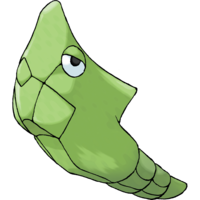Metapod (Pokémon)
|
|
|
| ||||||||||||||
| ||||||||||||||
|
| |||||||||||||
|
| |||||||||||||
| ||||||||||||||
| ||||||||||||||
| ||||||||||||||
|
| |||||||||||||
|
| |||||||||||||
| ||||||||||||||
| ||||||||||||||
| ||||||||||||||
| ||||||||||||||
Biology
Physiology
While Metapod is classified as a cocoon Pokémon, it bears more resemblance to a chrysalis. Its soft body is protected by a hard outer shell while it undergoes metamorphosis. While this shell is said to be as hard as steel, a large sudden impact could cause its vulnerable body to pop out, leaving it completely exposed. It shares many physiological and behavioral characteristics with Kakuna, suggesting that they may have a distant relationship.
Gender differences
None.
Special abilities
Metapod posses a very limited range of movement. However, by hardening their outer shell, they can protect themselves from most kinds of enemies.
Behavior
In order to conserve as much energy as possible, Metapod generally remain motionless. They can be very difficult to spot in the wild, because their green coloration helps them blend in with the tree-top canopies. If it is discovered by an enemy it is unable to do anything other than harden its outer shell. While this is enough to deter most predators it does not offer complete protection, as the Metapod's insides still remain soft and vulnerable. Its second line of defense is to drop of the trees using String Shot. Because of its vulnerability, Metapod evolve rapidly into their final evolutionary stage.
Habitat
Metapod can often be found in wooded areas, such as Viridian Forest. They dangle themselves from leafy canopies using String Shot.
Diet
Main article: Pokémon food
Metapod does not eat. It relies on the energy it stored as a Caterpie.
In the anime
Ash Ketchum had a Metapod that he caught as a Caterpie and evolved in Ash Catches a Pokémon. It eventually evolved into Butterfree in Challenge of the Samurai.
In Gettin' The Bugs Out, Bugsy used a Metapod against Ash for the Gym Battle. Unlike most Metapods, this one was actually able to fight back!
In Caterpie's Big Dilemma, Zander's Caterpie became giant-sized after eating some enhanced Rare Candies. Zander's Caterpie knocked down part of a radio tower in order to make a place for it to evolve into Metapod.
In the manga
Pokémon Special
Metapod's first appearance is a cameo in Bulbasaur, Come Home! as one of the Pokémon that escapes from Professor Oak's Laboratory. Also, Yellow's Caterpie was a Metapod briefly before evolving again into Butterfree. Bugsy also uses two Metapod on his team.
In the TCG
Four Metapod cards have been released.
Game data
NPC appearances
- Pokémon Mystery Dungeon: Metapod is Caterpie's friend.
Pokédex entries
| ||||||||||||||
| ||||||||||||||
| ||||||||||||||
| ||||||||||||||
| ||||||||||||||
| ||||||||||||||
Alternate Games
- Pokémon Pinball, Pokémon Trading Card Game (Base Set, Base Set 2, Legendary Collection)
- This Pokémon is vulnerable to attack while its shell is soft, exposing its weak and tender body.
- Pokémon Trading Card Game (Neo Discovery)
- Inside the shell, it is soft and weak as it prepares to evolve. It stays motionless in the shell.
Game locations
| |||||||||||||||||||||||||||||
| |||||||||||||||||||||||||||||
| |||||||||||||||||||||||||||||
| |||||||||||||||||||||||||||||
| |||||||||||||||||||||||||||||
| |||||||||||||||||||||||||||||
In side games
| Game | Location |
|---|---|
| Pokémon Snap | River |
| Pokémon Trozei | SOL Laboratory 2 Secret Storage 8 Endless Level 4 Mr. Who's Den |
| Pokémon Mystery Dungeon | Joyous Tower (7F-8F) |
Base stats
| Stat | Range | ||
|---|---|---|---|
| At Lv. 50 | At Lv. 100 | ||
HP: 50
|
110 - 157 | 210 - 304 | |
20
|
22 - 79 | 40 - 152 | |
55
|
54 - 117 | 103 - 229 | |
25
|
27 - 84 | 49 - 163 | |
25
|
27 - 84 | 49 - 163 | |
30
|
31 - 90 | 58 - 174 | |
Total: 205
|
Other Pokémon with this total | ||
Type effectiveness
Template:DP type effectiveness
In Generation I, the effectiveness of Poison-type moves is 200.
Learnset
By leveling up
| Level | Generation I | Generation II | Generation III | Generation IV |
|---|---|---|---|---|
| Previous | Tackle String Shot |
Tackle String Shot |
Tackle String Shot |
Tackle String Shot |
| Start/7 | Harden | Harden | Harden | Harden |
Side game data
Evolution
Trivia
Origin
Its design appears to be based upon a generic butterfly chrysalis, most likely a Cabbage White or Swallowtail chrysalis.
Name origin
Metapod's name is a combination of metamorphosis and pod, referring to its chrysalis state. Its Japanese name appears to be a combination of transform and cell.
In other languages
Related articles
External links
|
|
|

|
This Pokémon article is part of Project Pokédex, a Bulbapedia project that aims to write comprehensive articles on each Pokémon species, as well as Pokémon groups and forms. |

